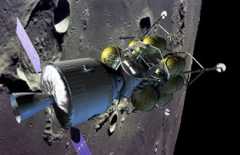From SPACE.com — Gravity-Powered Asteroid Tractor Proposed to Thwart Impact:
A concept spacecraft could use gravity to tow asteroids away from a collision course with earth. Credit: Dan Durda – FIAAA / B612 Foundation.
An asteroid the size of two football fields could wipe out a large city or set off a series of tsunamis across the world. The threat of such an Earth-smashing asteroid has lead scientists to dream up several methods of defending the planet against such a catastrophe.
Solutions have ranged from pushing the asteroid with a spacecraft to mounting a thruster on its surface. But pushing it would require too much fuel and could break up the asteroid. Also, asteroids rotate, which could complicate the firing of a surface thruster.
Now, two NASA astronauts have presented a plan for an “asteroid tractorâ€â€”an unmanned, 20-ton spacecraft that uses the invisible bond of gravity to gently pull an asteroid into a new, non-threatening orbit.
Related item: check out my Space Rocks animation.
UPDATE: The Space Tractor is featured on today’s Astronomy Picture of the Day.

 Image left: NASA’s new crew exploration vehicle in lunar orbit. Artist’s concept by John Frassanito and Associates.
Image left: NASA’s new crew exploration vehicle in lunar orbit. Artist’s concept by John Frassanito and Associates. With the closest approach until 2018 of the planet MARS this month, you might want to bone up on Martian lore and history (from an Earthbound perspective). This is a link to a very entertaining and informative site called
With the closest approach until 2018 of the planet MARS this month, you might want to bone up on Martian lore and history (from an Earthbound perspective). This is a link to a very entertaining and informative site called